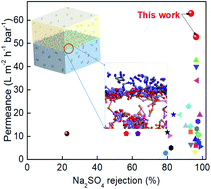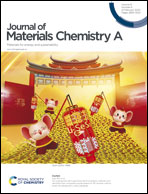Hydrogel assisted interfacial polymerization for advanced nanofiltration membranes†
Abstract
With the rapid growth of the world population and water contamination, nanofiltration membranes with extraordinary permeance and high salt rejection are eminently desirable for addressing global water scarcity. Here, an innovative approach to design thin film composite (TFC) membranes with ultrahigh permeance via hydrogel assisted interfacial polymerization is reported. The hydrogel containing piperazine (PIP) monomers serving as an aqueous phase in interfacial polymerization enable homogeneous interfacial polymerization, reducing the diffusion rate of the PIP monomers, and providing mechanical strength to the thin polyamide (PA) selective layer. As a result, the synthesized advanced TFC membranes have ultrahigh high permeances of 52.8 and 62.9 L m−2 h−1 bar−1 while maintaining satisfactorily high rejections of 96.4% and 93.5% for Na2SO4, demonstrating a desalination performance superior to the PA TFC nanofiltration membranes reported so far. Moreover, the mechanism behind the exceptional high permeance is delineated by exploring theoretical hydrogel assisted interfacial polymerization via simulation. Most importantly, the fabrication process of the hydrogel-TFC membranes is simple, enabling cost-efficient and scalable manufacturing.



 Please wait while we load your content...
Please wait while we load your content...